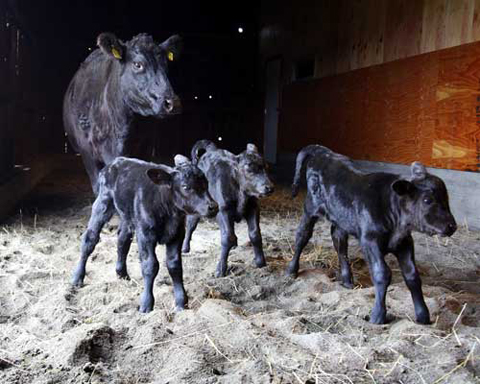
By Melissa Simon, Eureka Times-Standard
From the San Jose Mercury News.
A Eureka cow has beaten the odds this week, giving birth to three calves.
Dubbed Mo, Larry and Curly by owner Trina Wilson, the Angus calves were born on Tuesday at 2 p.m. at the A1 Ranch in Eureka. All are doing well.
Franz Rulofson, a professor of agriculture at College of the Redwoods, said triplets are a little more rare in Angus cows than dairy cows.
”The normal twinning rate for cows is 1 percent of all pregnancies but triplets are 1 in 105,000, which is not very big,” he said.
Wilson and her husband — hired hands at Burnt Ranch — also watch over the cows at a pasture they rent at A1 Ranch in Eureka.
”We went out to check on the cows and saw that one of them was getting ready to give birth,” Wilson said. “There were four feet sticking out, one calf was breaching, so I told my husband that we better help.”
Wilson, who has 30 cows and has been breeding them for 25 years, said the first calf was pretty scrawny and the second was not too much bigger.
”I told my husband to check for another one just in case and he said, ‘By golly, there’s another one,’” she said. “The third calf was middle-sized compared with the other two.”
The calves weighed around 40 pounds each, which is on the smaller side. Wilson said calves are normally between 60 and 80 pounds.
”The mom, No. 519 because she doesn’t have a name, is a really good mom,” she said. “She knows she has three calves and is attentive to all of them. Some of the time, when cows have more than one calf, they don’t pay enough attention to both of them and one of them will get ignored, but this isn’t the case.”
Wilson said the next step, once they start nursing more, will be to get another nurse cow because the mom most likely will not have enough milk to feed all three.
”Cows can easily handle two calves but they will generally milk out a cow, not in the first week, but after that so another nursing cow would be good to have,” said Rulofson.
David Renner, a dairyman at Diamond Point Dairy in Ferndale, said he could not remember one of his cows having triplets in his 32 years as a dairyman.
”I remember another dairy farm that had triplets about 12 or so years ago,” he said. “They were all females and they were named Snap, Crackle and Pop after the cereal.”
While the triplets are unusual, Rulofson said an even rarer occurrence would be if the three were identical, which happens when the calves are all the same sex, all the same color and have the exact same noseprint.
”Whether these calves are identical or not, it would still be fun to see something, like a multiple birth, that is not so common,” Rulofson said.
